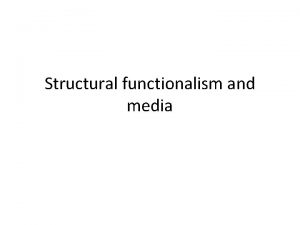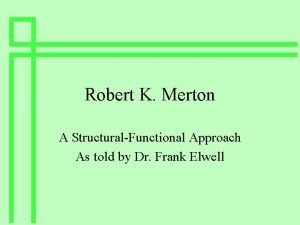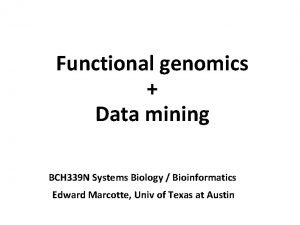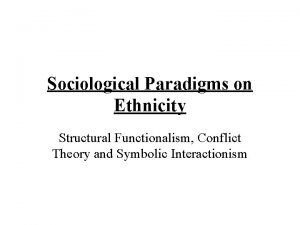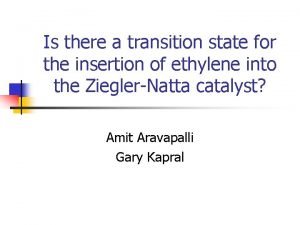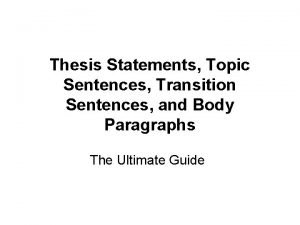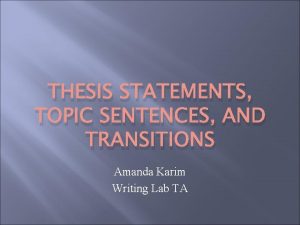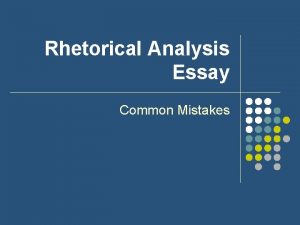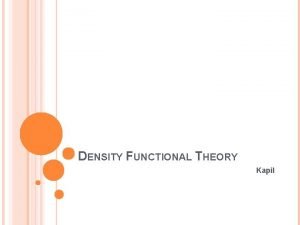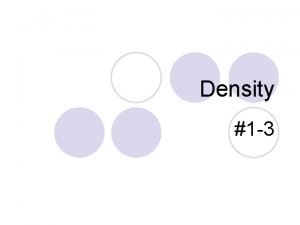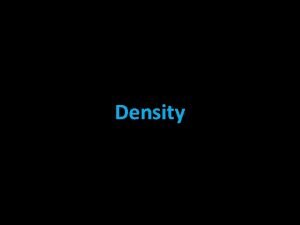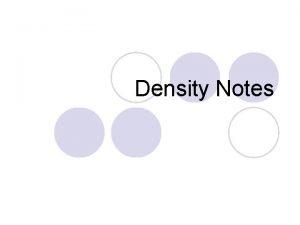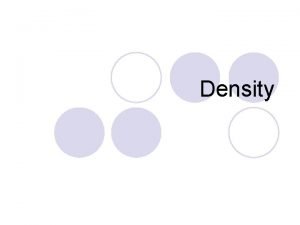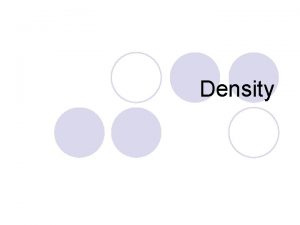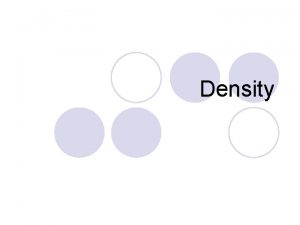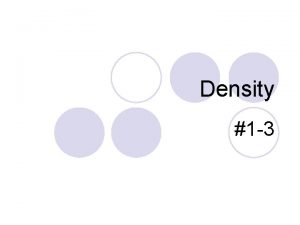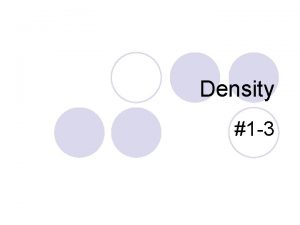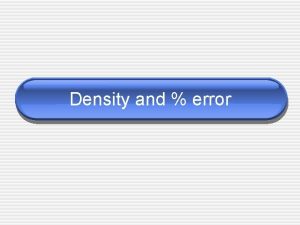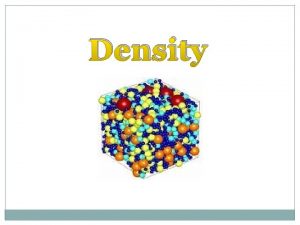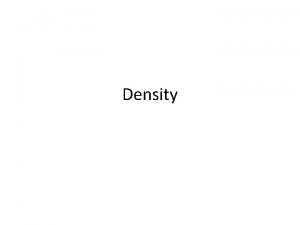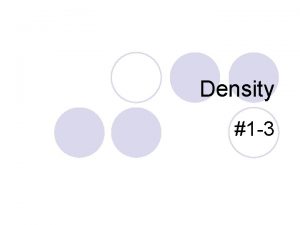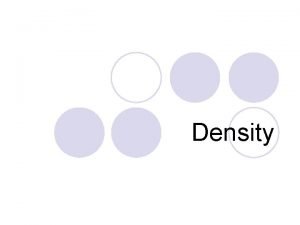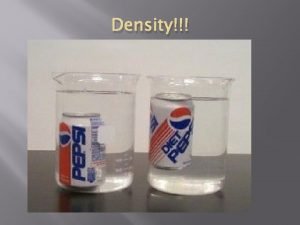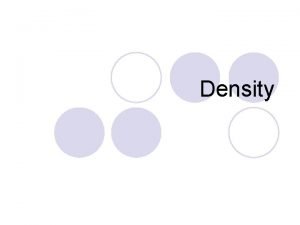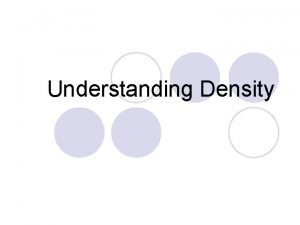Insight into Structural Phase Transitions from Density Functional




































- Slides: 36

Insight into Structural Phase Transitions from Density Functional Theory Adrienn Ruzsinszky Department of Physics Temple University Philadelphia SUPPORTED BY DOE ES 2014, Denton, Texas, 2014

What kinds of phase transitions exist? • Under pressure Si displays 11 phases with an increase in coordination number and a transition from semiconductor to metal • Silica exists in various crystalline polymorphs and in glassy phase • H 2 O ice is one of the most abundant planet forming materials and its phase diagram is of fundamental scientific interest. It is crucial for modeling the interiors of icy planetary giants • Molecular crystals for drug design exist in different polymorphs with very small energy difference M. T. Yin and M. L. Cohen, Phys. Rev. Lett. 45, 1004 (1980) N. R. Keskar and J. R. Chelikowsky, Phys. Rev. B 46, 1 (1992) J. B. Neaton, N. W Ashcroft, Nature , 400, 141, (1999) K. A. Johnson, N. W. Ashcroft, Nature, 403, 632 (2000) B. Militzer and H. F. Wilson, Phys. Rev. Lett. 105, 195701 (2010) M. Ji, K. Umemoto, C-Zh. Wang, K-M. Ho, and R. M. Wentzcovitch, Phys. Rev. B 84, 220105(R) (2011) 2

Motivation: • to understand long-standing and fundamental problems in solidstate physics and materials science • reconcile theory with experiment • give more insight in materials problems from the DFT aspect • experimental realization of some phase transitions is extremely difficult (structural phase transition of hydrogen from a protonpaired insulator into a monatomic metal ~342 GPa) q Simple: the prediction of the most stable crystal structure, the static properties such as the equilibrium lattice constant, cohesive energy, and bulk modulus. q Complex: Common materials problems like adsorption on surfaces or structural phase transitions. 3

In Complex materials problem we often face dilemmas when testing density functional approximations: Adsorption on surfaces: adsorption energy vs. site preference J. Sun, M. Marsman, A. Ruzsinszky, G. Kresse and J. P. Perdew, Phys. Rev. B 83, 121410(R) (2011). Structural phase transitions: energy-geometry dilemma Can a meta-GGA predict good results for the equilibrium lattice properties of two polymorphs of a solid, as well as the phase transition parameters such as energy difference and transition pressure, simultaneously? 4

Structural transitions of solids under pressure Often we need to calculate small energy differences accurately. For the lattice constant of a solid, this small energy difference is associated with a small change of external potential, so errors in approximate functionals tend to cancel out. Thus even LDA can predict useful lattice constants. For the structural phase transitions, this small energy difference is associated with a large change of external potential. Less error cancellation is expected, making the prediction of the transition pressure challenging. 5

The computationally efficient semilocal density functional approximations for the xc energy require a single integration over the 3 D space. Meta-GGA’s have more ingredients, and can satisfy more exact constraints, than GGA’s. Thus meta-GGA’s can achieve higher simultaneous accuracy for molecules, clusters, solids, surfaces, and molecules bound to surfaces. It seems that they can also achieve higher accuracy for weak bonds. But the existing nonempirical meta-GGA’s (e. g. , TPSS and rev. TPSS) are not better than GGA’s for weak bonds. JP. Perdew and K. Schmidt, in Density Functional Theory and its Application to Materials, edited by V. van Doren, C. Van Alsenoy and P. Geerlings, (AIP, Melville, NY, 2001) J. Tao, J. P. Perdew, V. N. Staroverov and G. E. Scuseria, Phys. Rev. Lett. 91, 146401 (2003). J. P. Perdew, A. Ruzsinszky, G. I. Csonka, L. A. Constantin and J. Sun, Phys. Rev. Lett. 103, 026403 (2009). 6

D. R. Hamann 1996 showed that the PBE GGA was much better than LDA for the transition pressures of silicon and silicon dioxide under pressure. This work motivated many solid state physicists to switch from LDA to GGA. D. R. Hamann, Phys. Rev. Lett. 76, 660 (1996). J. W. Wilkins and collaborators found that the TPSS meta-GGA was considerably worse than the PBE GGA for these transition pressures: R. G. Hennig, A. Wadehra, K. P. Driver, W. D. Parker, C. J. Umrigar and J. W. Wilkins, Phys. Rev. B 82, 014101 (2010) E. R. Batista, J. Heyd, R. G. Hennig, B. P. Uberuaga, R. L. Martin, G. E. Scuseria, C. J. Umrigar and J. W. Wilkins, Phys. Rev. B 74, 121102 (R) (2006) K. P. Driver, R. E. Cohen, Z. Wu, B. Militzer, P. López. Ríos, M. D. Towler, R. J. Needs and J. W. Wilkins, Proc. Nat. Acad. Sci. (USA) 107, 9519 (2010) This suggested to us that TPSS and rev. TPSS were not optimal meta-GGAs. 7

With three ingredients even for spin-unpolarized densities, the meta-GGA form offers rich possibilities to satisfy known exact constraints on the density functional for the exchange-correlation energy, and to achieve high accuracy with or without empiricism. Our latest meta-GGAs (MGGA_MS family) already seem to be reliably accurate for many purposes, but we are working to improve them further. J. Sun, B. Xiao and A. Ruzsinszky, J. Chem. Phys. 137, 051101 (2012) 8

The third-order Birch-Murnaghan equation of state: E Structure A E 0: equilibrium energy V 0: equilibrium volume Structure B VA VB V B 0: bulk modulus B 0’: the pressure derivative of the bulk modulus F. D. Murnaghan, Proc. Natl. Acad. Sci. 30, 244 (1944) The largest error in theoretical transition pressure arises because the EOS of one phase displays an erroneous rigid vertical shift with respect to that of the other. 9

The phase transition under pressure in Si insulator-to-metal transformation The obtained energy–volume curves were fitted to the analytic third-order Birch -Murnaghan equation of state for E(V), the total energy of the unit cell of volume V, which may include the ZPE and finite temperature correction. 10

The structural and phase transition parameters of the D-Si (LP) and β-tin Si (HP) phases. We define and Properties LDA PBE TPSS rev. TPSS reg. TPSS MGGA_ HSE 06 MS 0 RPA Expt. V 0 (Å3/atom) 19. 71 20. 40 20. 25 20. 10 20. 04 20. 13 20. 05 20. 02 20. 0 β-tin V 0 (Å3/atom) 14. 81 15. 30 15. 02 14. 85 15. 06 15. 09 14. 81 15. 24 — Phase transition properties ΔE 0 (e. V/atom) 0. 206 0. 290 0. 265 0. 160 0. 285 0. 517 0. 398 0. 37 — ΔV 0 (Å3/atom) 4. 90 5. 10 5. 24 5. 25 4. 98 5. 04 5. 35 4. 78 — Pt (GPa) 5. 7 8. 4 7. 3 3. 7 8. 0 17. 3 13. 3 12. 2 10~14 D-Si R. G. Hennig, A. Wadehra, K. P. Driver, W. D. Parker, C. J. Umrigar and J. W. Wilkins, Phys. Rev. B 82, 014101 (2010) J. Z. Hu, L. D. Merkle, C. S. Menoni and I. L. Spain, Phys. Rev. B 34, 4679 (1986) E. R. Batista, J. Heyd, R. G. Hennig, B. P. Uberuaga, R. L. Martin, G. E. Scuseria, C. J. Umrigar and J. W. Wilkins, Phys. Rev. B 74, 121102 (R) (2006) R. Maezono, N. D. Drummond, A. Ma and R. J. Needs, Phys. Rev. B 82, 184108 (2010) B. Xiao, J. Sun, A. Ruzsinszky, J. Feng and J. P. Perdew, Phys. Rev. B. , 86, 094109 (2012) 11 B. Xiao, J. Sun, A. Ruzsinszky, J. Feng, R. Haunschild, G. E. Scuseria, and J. P. Perdew, Phys. Rev. B 88, 184103 (2013)

The phase transition under pressure in Si. O 2 insulator-to-insulator phase transition 12

The structural and phase transition parameters of the α-quartz(LP) and stishovite(HP) phases. Properties LDA PBE TPSS rev. TPSS reg. TPSS MGGA _MS 0 HSE 06 RPA Expt. α-quartz V 0 (Å3/Si. O 2) 36. 95 39. 41 39. 17 39. 15 39. 00 38. 37 38. 28 37. 75 37. 73 22. 96 24. 04 23. 68 23. 59 23. 42 23. 22 23. 66 23. 30 stishovite V 0 (Å3/Si. O 2) Phase transition properties ΔE 0 (e. V/Si. O 2) -0. 031 0. 532 0. 384 0. 189 0. 167 0. 484 0. 39 0. 51~0. 54 ΔV 0 (Å3/Si. O 2) 13. 99 15. 37 15. 46 15. 47 15. 41 14. 96 15. 06 14. 09 14. 43 Pt (GPa) -0. 37 6. 94 2. 66 2. 48 6. 16 6. 24 5. 6 7. 46 3. 84 J. L. Holm, O. J. Kleppa, and E. F. Westrum, Jr. , Geochim. Cosmochim. Acta 31, 2289 (1967) M. Akaogi and A. Navrotsky, Phys. Earth Planet. Inter. 36, 124 (1984) B. Xiao, J. Sun, A. Ruzsinszky, J. Feng and J. P. Perdew, Phys. Rev. B. , 86, 094109 (2012) A. Ruzsinszky, J. P. Perdew and G. I. Csonka, J. Chem. Theory. Comput. 6, 127 (2010) A. Ruzsinszky, J. P. Perdew, and G. I. Csonka, J. Chem. Phys. 134, 114110 (2011) B. Xiao, J. Sun, A. Ruzsinszky, J. Feng, R. Haunschild, G. E. Scuseria, and J. P. Perdew, Phys. Rev. B 88, 184103 (2013) 13

The phase transition under pressure in Zr metal-to-metal phase transition 14

The structural and phase transition parameters of the ω-Zr (LP) and β-Zr(HP) phases. Properties LDA PBE TPSS rev. TPSS reg. TPSS MGGA HSE 06 Expt. _MS 0 ω-Zr (hcp) V 0 (Å3/atom) 21. 54 22. 86 22. 61 22. 49 22. 40 22. 66 22. 96 23. 09 a β-Zr (bcc) V 0 (Å3/atom) 20. 86 22. 56 22. 26 22. 08 22. 05 22. 21 22. 89 22. 82 Phase transition parameters ΔE 0 (e. V/atom) 0. 059 0. 084 0. 087 ΔV 0 (Å3/atom) 0. 690 0. 300 0. 352 Pt (GPa) 9. 17 23. 21 22. 56 0. 087 0. 410 21. 78 0. 088 0. 362 26. 62 0. 113 0. 459 31. 25 0. 200 0. 065 — — 0. 270 30± 2 B. Xiao, J. Sun, A. Ruzsinszky, J. Feng, R. Haunschild, G. E. Scuseria, and J. P. Perdew, Phys. Rev. B 88, 184103 (2013) 15

This ‘MGGA_MS” exists in three similar versions: MGGA_MS 0 (no empirical parameter): Sun et all. , J. Chem. Phys. 137, 051101 (2012) MGGA_MS 1 and MGGA_MS 2 (1 or 2 empirical parameters): Sun at all. J. Chem. Phys. 138, 044113 (2013) Sun at all. Phys. Rev. Lett. 111, 106401 (2013) MGGA_MS 2 has two non-empirical parameters μGE and c (from the slowly-varying electron gas and the hydrogen atom), plus two empirical parameters κ and b (fitted to AE 6 atomization energies and BH 6 barrier heights). We hope to purge the empirical parameters in the future, replacing them by additional constraints: • tight Lieb-Oxford bound for M. M. Odashima and K. Capelle, J. Chem. Phys. 127, 054106 (2007) • non-uniform density scaling M. Levy, Phys. Rev. A 43, 4637 (1991) L. Chiodo, L. A. Constantin, E. Fabiano and F. D Sala, 108, 126402 (2012) J. M. del Campo, J. L. Gazquez, S. B. Trickey, and A. Vela, Chem. Phys. Lett. 543, 179 (2012) 16

The electronic band gaps The band-gaps of the D-Si, α-quartz and stishovite structures estimated from the calculated band-structure DOS by semilocal and non-local functionals. Notice that the band gap of Si is indirect [Г= (0, 0, 0) to X = (2π/a) (1, 1, 0)]; α-quartz also has an indirect band gap [K= ((2π/a) (1/√ 3, 1/3, 0) to Г]; the band gap of stishovite is direct at the Г point. Structure D-Si α-quartz Stishovite LDA 0. 49 5. 68 5. 90 PBE 0. 62 5. 70 5. 13 TPSS 0. 38 5. 94 5. 56 rev. TPSS 0. 25 5. 50 5. 17 reg. TPSS 0. 25 5. 52 5. 17 MGGA_MS 0 0. 17 5. 60 4. 25 HSE 06 1. 14 7. 50 8. 06 GW 0 1. 22 9. 40 8. 90 Expt. 1. 17 8. 90 5~6 8. 75 L. Schimka, J. Harl and G. Kresse, J. Chem. Phys. 134, 024116 (2011) G. Kresse, M. Marsman, L. E. Hintzsche and E. Flage-Larsen, Phys. Rev. B 85, 045205 (2012) R. B. Laughlin, Phys. Rev. B 22, 3021 (1980) G. Wiech, Solid State Commun. 52, 807 (1984) A. N. Trukhin, T. I. Dyuzheva, L. M. Lityagina and N. A. Bendeliani, Solid State Commun. 131, 1(2004) 17

Contrary to suggestions by Wilkins et al, the underestimation of the fundamental band gap in GGA and meta-GGA has nothing to do with the accuracy of these functionals for the transition pressures. „HSE 06 (Heyd-Scuseria-Ernzerhof) is fully nonlocal and predicts more realistic fundamental gaps. HSE 06 is better than the semilocal functionals for the transition pressures of Si and Si. O 2, but seriously overestimates the transition pressure in Zr. ” B. Xiao, J. Sun, A. Ruzsinszky, J. Feng, R. Haunschild, G. E. Scuseria, and J. P. Perdew, Phys. Rev. B 88, 184103 (2013) 18

The equilibrium cell volumes Equilibrium volumes of the Si, Si. O 2 and Zr structures computed by DFT+D 2 and opt. B 86 b-vd. W methods, which introduce long-range van der Waals attraction. For the Si. O 2 system, the unit is Å 3/Si. O 2; for the other two systems it is Å 3/atom. LP and HP indicate the low-pressure and high-pressure structures. Structures PBE+D 2 TPSS+D 2 MGGA_ MS 0 20. 13 15. 09 38. 37 23. 42 RPA Expt 19. 44 14. 46 37. 02 23. 49 opt. B 86 bvd. W 19. 98 15. 21 34. 56 23. 29 D-Si (LP) β-tin Si (HP) α-quartz (LP) Stishovite (HP) ω-Zr (LP) β-Zr (HP) MAE 19. 81 15. 03 38. 75 23. 83 20. 02 15. 24 37. 75 23. 66 20. 00 — 37. 73 23. 30 23. 17 22. 53 0. 38 22. 90 22. 19 0. 51 21. 46 21. 13 1. 09 22. 66 22. 21 0. 35 — — — 23. 09 22. 82 — B. Xiao, J. Sun, A. Ruzsinszky, J. Feng, J. P. Perdew, Phys. Rev. B 86, 094109, (2012) R. G. Hennig, A. Wadehra, K. P. Driver, W. D. Parker, C. J. Umrigar and J. W. Wilkins, Phys. Rev. B 82, 014101 (2010) Y. J. Hao, L. Zhang, X. R Chen, Y. H. Li and H. L He, J. Phys. : Condens. Matter. 20, 235230 (2008) B. B. Karki, M. C. Warren, L. Stixrude, G. J Ackland J. Crain, Phys. Rev. B 55, 3465, (1997) 19

The phase transitions and sublimation energies in ice The sublimation energies (me. V) of 3 ice phases (the zero-point energy is omitted). Ice LSDA PBE rev. TPSS+D 2 rev. TPSS MGGA + _MS 2 vd. W opt. B 88 + Expt. vd. W Ih 943 636 570 720 644 602 696 610 II 896 567 504 690 630 586 699 609 VIII 813 459 423 675 569 532 670 577 MARE % 47. 5 10. 5 16. 7 16. 1 3. 5 4. 3 15 B. Santra, J. Klimeš, D. Alfѐ, A. Tkatchenko, B. Slater, A. Michaelides, R. Car, and M. Scheffler, Phys. Rev. Lett. 107, 185701 (2011) E. D. Murray and G. Galli, Phys. Rev. Lett. 108, 105501 (2012) Y. Fang, B. Xiao, J. Tao, J. Sun and JP. Perdew, Phys. Rev. B 87, 214101 (2013) 20

Transition pressure (ptr) from Ice Ih to HP Ice VIII plotted versus transition pressure from Ice Ih to LP Ice II B. Santra, J. Klimeš, D. Alfѐ, A. Tkatchenko, B. Slater, A. Michaelides, R. Car, and M. Scheffler, Phys. Rev. Lett. 107, 185701 (2011) Y. Fang, B. Xiao, J. Tao, J. Sun and JP. Perdew, Phys. Rev. B 87, 214101 (2013) 21

The key new message from the results: By using the right dimensionless ingredient (α), a meta GGA can recognize and give a different GGAlevel description to each of three kinds of bonding regions in a molecule or solid: 1) Covalent bonds 2) Metallic bonds 3) Weak or vd. W bonds Well-designed meta-GGAs appear to maximize the ratio ACCURACY/(COMPUTATIONAL COST) 22

Meta-GGA made simple (MGGA_MS) = reduced density gradient. use α to interpolate between GGA’s for α=1 and α=0 and to extrapolate monotonically to dimensionless deviation from the single orbital shape 23

The enhancement factor of the MGGA_MS family of meta-GGA’s. The left figure shows the Fx and the right figure shows the α and s dependence of Fx respectively The main difference between the MGGA_MS family of density functionals and other tested functionals lies in the exchange enhancement factor Fx(s, α), where the weaker sdependence in MGGA_MS is countered by a stronger α dependence. Fx is monotonically decreasing with α in MGGA_MS (but not in rev. TPSS). This is the key to a good description of weak bonds. Our recent works has revealed the significance of α for identifying different bonds in molecules and solids 24

First step: An artificial order-of limits problem arises in the TPSS and rev. TPSS meta-GGA’s due to use of BOTH z and α For the fix-up of the order-of limits anomaly, see: A. Ruzsinszky, J. Sun, B. Xiao and G. I. Csonka, J. Chem. Theory. Comput. 8, 2078 (2012) Our newer meta-GGAs use only alpha, and so avoid this problem. 25

Properties TPSS rev. TPSS reg. TPSS Phase transition properties of D-Si and β-tin ΔE 0 0. 265 0. 160 0. 285 (e. V/atom) 0. 266 ΔV 0 (Å3/atom) Pt (GPa) MGGA_ MS 0 MGGA_ MS 2 HSE 06 Expt 0. 517 0. 429 0. 398 0. 390 0. 447 5. 35 — 13. 3 12. 4 10~14 11~15 5. 24 5. 25 4. 98 5. 04 4. 98 7. 3 3. 7 8. 0 17. 3 13. 9 — 26

The exchange enhancement factor for MGGA_MS 0. Focus on the front plane in which s=0, as at a typical bond center. In GGA, the enhancement factor in this plane would equal 1. In the rev. TPSS meta-GGA, it would be nearly equal to 1 except very close to alpha=0. 27

Second step: Arguments of the meta-GGA exchange enhancement factor =reduced or dimensionless density gradient ? = z, t-1 or α =reduced variable for the KE density where Which is the best? 28

Previous semilocal approximations (e. g. , rev. TPSS) can usefully describe covalent, ionic, metallic, and some hydrogen bonds. But they are not reliable for weak or vd. W bonds (important for soft or biological matter). Of course, no semilocal approximation can describe the long-range-part of the vd. W interaction. But the empirical meta-GGA’s from the Truhlar group give a useful description of the intermediate-range or equilibrium part in molecules. Can we see how to do the same with non-empirical or minimally-empirical meta-GGA’s, that are also useful for solids? 29

G. K. H. Madsen. ; L. Ferrighi. ; and B. Hammer, . J. Phys. Chem. Lett. , 1, 515 (2010) Y. Zhao, and D. G. Truhlar, J. Chem. Phys. 125, 194101 (2006) (used in TPSS and rev-TPSS) (used in BECKE and TRUHLAR functionals) 1) Regions of one- and two-electron density: (single bonds) 2) Regions of uniform density: (metallic bonds) 3) Regions of density overlap between closed shells: (weak bonds) as z cannot distinguish between regions 2) and 3). t-1 cannot clearly distinguish between regions 1) and 2). Only α can recognize these three regions and treat them differently. A. D. Becke and K. E. Edgecombe, J. Chem. Phys. 92, 5397 (1990) 30

Plots of rs, s and α along the line through the bond in the lowpressure phases of Si and the exchange energy density A and B indicate the interstitial and single bond regions 31

Plots along the bond axis between two argon atoms separated by 7 Angstroms 32

Alternative descriptions of VDW in Density Functional Theory better describe the long-range part: (A) Langreth-type fully nonlocal functionals or double integrals over 3 d space (good for vd. W but not so good for other bonds). Dion, M. ; Rydberg, H. ; Schroeder, E. ; Langreth, D. C. ; Lundqvist, B. I. Phys. Re. V. Lett. , 92, 246401 (2004) O. A. Vydrov and T. Van Voorhis, Phys. Rev. A. 81, 062708 (2010) (B) Pair-wise atom-atom interaction models for the long-range correction to a semilocal functional, e. g. , Grimme’s DFT-D correction (highly parametrized. ) A. D. Becke and E. R. Johnson, J. Chem. Phys. 122, 154104 (2005) A. Tkatchenko and M. Scheffler, Phys. Rev. Lett. 102, 073005 (2009) Y. Andersson, D. C. Langreth, and B. I. Lundqvist, Phys. Rev. Lett. 76, 102 (1996) J. F. Dobson and B. P. Dinte, Phys. Rev. Lett. 76, 1780 (1996) J. Tao, J. P. Perdew, and A. Ruzsinszky, Phys. Rev. B 81, 233102 (2010) S. Grimme, J. Comp. Chem. 25, 1463 (2004) Both are inaccurate for pairs of large fullerenes and for large nano-sheets or long nano-tubes. A. Ruzsinszky at all. Phys. Rev. Lett. 109, 233203 (2012) J. F. Dobson, A. White and A. Rubio, Phys. Rev. Lett. 96, 073201 (2006) 33

We have found that all versions of MGGA_MS are better than TPSS and rev. TPSS meta-GGA, or even PBE GGA, for the structural phase transition pressures of Si (insulator to metal) Si. O 2 (insulator to insulator) Zr (metal to metal). We can understand this in terms of the two new MGGA_MS features in the alpha-dependence of the exchange enhancement factor. 34

Possible future refinements of the META-GGA MADE SIMPLE: Make a “FULLY-CONSTRAINED META-GGA” based on α Add a Langreth-type correction only for the most long-ranged part of the vd. W interaction. Make a Perdew-Zunger-like self-interaction correction to describe “STRONGLY-CORRELATED” SYSTEMS. 35

Conclusions The proper meta-GGA dimensionless ingredient to recognize all degrees of orbital overlap is using α, we can describe all bonds, even weak ones, with useful accuracy, with few empirical parameters (or perhaps none). We have also found that MGGA_MS is accurate for solid transition pressures, while other meta-GGAs like rev. TPSS are not. 36
 Subir sachdev quantum phase transitions
Subir sachdev quantum phase transitions Specific gravity define
Specific gravity define Atomic planar density
Atomic planar density Crude population density vs physiological density
Crude population density vs physiological density Linear atomic density
Linear atomic density High density low density
High density low density Arithmetic density
Arithmetic density Structural functional analysis is given by
Structural functional analysis is given by Difference between structural and functional genomics
Difference between structural and functional genomics Structural functional analysis is given by
Structural functional analysis is given by Difference between structural and functional genomics
Difference between structural and functional genomics Structural functional analysis is given by
Structural functional analysis is given by Structural and functional diversity in protists
Structural and functional diversity in protists Figure 6-2 structure of a typical bone
Figure 6-2 structure of a typical bone Structural functional theory
Structural functional theory Ideas of structural functionalism
Ideas of structural functionalism Density functional theory
Density functional theory Semi fixed space maintainer
Semi fixed space maintainer Non functional plasma enzymes
Non functional plasma enzymes Plasma enzymes
Plasma enzymes Functional and non functional
Functional and non functional Normal phase vs reverse phase chromatography
Normal phase vs reverse phase chromatography Hplc reverse phase vs normal phase
Hplc reverse phase vs normal phase Mobile phase and stationary phase
Mobile phase and stationary phase Stationary and mobile phase
Stationary and mobile phase Normal phase vs reverse phase chromatography
Normal phase vs reverse phase chromatography Difference between phase voltage and line voltage
Difference between phase voltage and line voltage Hplc detector types
Hplc detector types In a triangle connected source feeding a y connected load
In a triangle connected source feeding a y connected load Broad phase vs narrow phase
Broad phase vs narrow phase Movie maker live
Movie maker live What holds paper together
What holds paper together Transition word for thesis statement
Transition word for thesis statement Topic sentence and thesis statement
Topic sentence and thesis statement Script writing elements
Script writing elements Modern project profiles in software project management
Modern project profiles in software project management Transitions for rhetorical analysis
Transitions for rhetorical analysis







